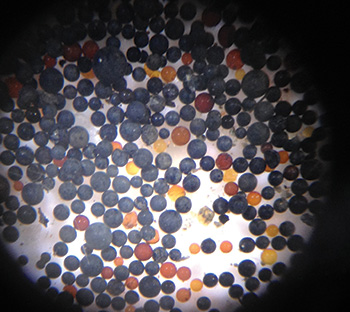About the 2015-2017 Trottier Fellows

Jeffrey McKenzie

Anthony Ricciardi

Nancy Ross
Jeffrey McKenzie
Biography
Dr. Jeffrey McKenzie is an Associate Professor in the Department of Earth and Planetary Sciences at McGill University. Dr. McKenzie is an environmental geoscientist, with an expertise is cryohydrogeology – the study of the interactions between climate and groundwater in cold regions. His research projects focus on developing new numerical methods for investigating artic groundwater systems, studying how climate change is impacting glaciers and water in the Andes, and understanding the science behind water resources. Dr. McKenzie received his PhD from Syracuse University studying the groundwater systems of northern peatlands. He was then a Byrd Polar Research Fellow at The Ohio State University as part of the glacial-environmental assessment team, before starting at McGill in 2006.
Trottier Fellowship
Through the Trottier Public Science Policy Fellowship, Dr. McKenzie and his students will focus on how their cryohydrogeology research can inform the prediction and policy at the nexus between climate change in the Arctic, groundwater resources, and northern development. Dr. McKenzie has developed a new groundwater model designed for cold regions and permafrost landscapes. This exciting new tool can help elucidate this complex system and predict how climate change will affect cold regions. While academically beneficial, there is still a critical need to convert this scientific capital into societal relevance. The Trottier Public Science Policy Fellowship will lead to improved access and applicability of these tools for northern societies and researchers through stakeholder involvement, graduate student training, and workshop instruction.
Visit Jeffrey McKenzie's website.
Anthony Ricciardi
Biography
Dr. Anthony Ricciardi is an Associate Professor appointed to both the Redpath Museum and the McGill School of Environment, where he teaches courses on global environmental change, the ecology of invasive species, freshwater biology, and animal diversity. He received his Ph.D. from McGill in 1997 and completed postdoctoral work at Université Laval (as an NSERC Fellow) and Dalhousie University (as a Killam Fellow), prior to joining the McGill Faculty of Science in 2001. In 2002, he received a Quebec Strategic Professorship (FQRNT Stratégique – Professeurs-chercheurs). His research examines how freshwater ecosystems respond to anthropogenic stressors, especially biological invasions – the introduction and spread of nonindigenous species. He serves on the scientific committee of the Canadian Aquatic Invasive Species Network, an NSERC research group that assesses the risks of biological invasion in Canada’s lakes, rivers and coastal waters. He was invited to provide expert testimony on this issue to the House of Commons Committee on Fisheries and Oceans in 2003 and 2012, as well as technical advice to government and non-governmental agencies including the International Joint Commission, the NAFTA Commission for Environmental Cooperation, and the U.S. National Oceanic and Atmospheric Administration.
Trottier Fellowship
Microplastics – plastic particles (beads, pellets, fibres) smaller than a few millimetres in size – are an insidious form of pollution detected in lakes and rivers in recent years. The tiny size and buoyancy of microplastics allow some of them to pass through wastewater treatment facilities. In 2013, Dr. Ricciardi’s team found that microplastics are prevalent in St. Lawrence River sediments, indicating that the river is acting as a sink for this pollution. This is a concern because persistent toxic contaminants such as PCBs readily adsorb to microplastics, which can then transfer the contaminants and cause liver damage to fish that consume them.
The discovery of high concentrations of microplastics in the St. Lawrence River was widely covered in the media and provided impetus for proposed Canadian legislation to ban plastic microbeads from cosmetics and personal care products. Similar actions have been taken in the U.S., the European Union and Australia. However, cosmetics are only one (and possibly not the most important) source of the microplastics that are accumulating in our waterways. For example, polyethylene microbeads are also used by the shipping industry and in biotechnological applications. Additional forms of microplastics include paint particles, fragments of large plastic debris, and synthetic clothing fibres from domestic sewage (a single garment could produce up to 2000 fibres per laundry wash!). It is not clear which of these forms is more likely to enter food chains, and this raises the question of whether the current bandwagon of regulatory activity targeting cosmetic microbeads will be sufficient to mitigate ecological impacts.
To explore these issues, Dr. Ricciardi has assembled an interdisciplinary research group that includes colleagues from McGill, the St. Lawrence River Institute, the Quebec government, and the Ontario Ministry of Natural Resources, as well as undergraduate and graduate students. Using funding from the Trottier Fellowship, they will determine the forms and sources of microplastics that are most abundant in the St. Lawrence River and its tributaries, and explore the extent to which microplastics are being consumed by fish. Working with American and European colleagues, they will also seek to develop efficient sampling methods that could be used to monitor aquatic ecosystems and assess the effectiveness of new regulations. Finally, by connecting with other research groups, they plan to build an international network that can facilitate information sharing, compare methods and results, and advise policy makers on how best to manage this novel form of water pollution.

A sample of polyethylene microbeads (0.4–1 mm diameter) collected from St. Lawrence River sediments.
See documentary film (Le Code Chastenay) on microplastics research in the Ricciardi Lab.
Nancy Ross
Biography
Nancy Ross is Professor of Geography and an associate of the Department of Epidemiology and Biostatistics. Her research is focused on how the social and physical environments of places influence the health status of populations. Early in her career she published studies showing the remarkable social patterning of mortality in North American cities by the level of income inequality of those places. Inequality is fundamentally a property of place; we cannot ‘have’ inequality, but we can be ‘exposed’ to varying levels of inequality depending on where we live. Understanding how social and physical environmental features of places influence health is compelling given that the history of public health has shown us time and again that long-standing and far-reaching behaviour change is difficult to achieve in the absence of a supportive environment (take, for example, the vastly more effective legislative environmental changes to support nonsmoking compared to individual pharmacological approaches).
Ross and her students in the Health Geography Lab make use of the revolution of the availability of geographic data linked to Canada’s rich longitudinal and cross-sectional health survey and administrative data to resolve questions around neighbourhood environmental conditions, health-related behaviour, chronic disease onset and health care costs. A recent focus has been on the current thinking that well connected streets, a variety of services and access to public transportation are characteristics of places that increase the ‘walkability’ of places, and potentially, walking in people.
Originally from New Glasgow, Nova Scotia, Ross attended Queen’s University (BAH, MA) and McMaster University (PhD) before completing a postdoctoral fellowship with the Canadian Institute of Advanced Research (Population Health Program) and holding a research position with Statistics Canada. Ross has published more than 80 scientific articles and is the past Scientific-Editor-in-Chief of Health Reports – Canada’s flagship population health journal. She has held career awards with the Canadian Institutes of Health Research (CIHR) and the Fonds de recherche en Santé du Québec (FRSQ).
Trottier Fellowship
Jurisdictions world-wide are struggling to find policy responses to rising rates of obesity and obesity-related chronic disease. In 2006 in Canada, obesity accounted for $3.9 billion in direct health care costs (e.g., hospitalizations, medications, physician and emergency room visits) and $3.2 billion in indirect costs (e.g., costs related to disability and lost productivity due to illness or premature death) (Janssen 2013). Walking is a reasonably simple activity and the evidence that higher walking levels lead to substantial reductions in obesity-related chronic disease (e.g., type 2 diabetes, cardiovascular disease) is compelling (e.g., Smith et al., 2007; Yates et al., 2013). Despite the relative ease of walking and the evidence of its health benefits, ‘convincing’ people to walk for health and obesity reduction has proven difficult.
Well-connected streets, a variety of services, and access to public transport are thought to increase ‘walkability’ of places and, potentially, walking in people (Saelens and Handy, 2010). This type of utilitarian walking (walking for a specific purpose like to go to work or school) provides a convenient, low-cost, time-efficient method of physical activity that has very low barriers to entry in terms of physical capability. On September 9th, 2015 the Office of the Surgeon General of the United States launched a Call to Action on Promoting Walking and Walkable Communities. This is perhaps the strongest indication to date of the widespread scientific and policy interest in walkability of neighbourhoods.
This proposal is to support policy-amenable research on, and translation of research about, the most highly walkable places in Canada. These neighbourhoods will be identified from a variety of measures (street connectivity, landuse mix, access to green space and public transportation) and walking behaviour of their residents will be assessed using multiple waves of the Canadian health survey data. These highly walkable neighbourhoods will be the focus of in-depth study through a variety of methods including in-field auditing of local neighbourhoods, virtual auditing using Google StreetView® and investigator driven social surveys. The goal here is to learn the precise mix of urban amenities, street configurations, public transportation investments and socio-cultural dynamics that ‘produce’ a population that is highly engaged in utilitarian walking.
Visit Nancy Ross' webpages on McGill's Department of Geography website.